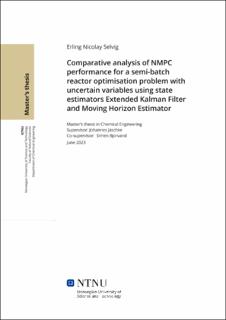| dc.contributor.advisor | Jäschke, Johannes | |
| dc.contributor.advisor | Bjorvand, Simen | |
| dc.contributor.author | Selvig, Erling Nicolay | |
| dc.date.accessioned | 2023-10-18T17:25:30Z | |
| dc.date.available | 2023-10-18T17:25:30Z | |
| dc.date.issued | 2023 | |
| dc.identifier | no.ntnu:inspera:146714212:28522509 | |
| dc.identifier.uri | https://hdl.handle.net/11250/3097377 | |
| dc.description.abstract | Nonlinear model predictive control (NMPC) er en optimaliseringsteknikk hvor
hovedmålet er å beregne kontrollhandlinger som forsikrer optimal drift av en pros-
ess. Dette gjøres ved å beregne kontrollhandlingsekvenser som sørger for trygg
og pålitelig drift av prosessen for fremtiden. Dersom NMPC-en skal beregne disse
sekvensene trenger den informasjon om prosessen den skal kontrollere og dette
oppgis som regel i form av ordinære differentialligninger og beskrankninger som
er påført optimaliseringsproblemet.
I praksis er det derimot ikke alltid mulig å tilføre NMPC-en informasjonen den kr-
ever, enten fordi tilstandene er umålelige eller usikre. Usikkerhet i en prosess kan
skyldes blant annet prosess- og målestøy og dersom NMPC-en ikke tar dette i be-
trakning når den løser optimaliseringsproblemet kan dette føre til sub-optimal eller
upresis kontroll av prosessen. Dersom informasjon om tilstandene som NMPC-en
kontrollerer er utiljengelige benyttes estimerte tilstander istedenfor og disse bereg-
nes med hjelp av tilstandmålinger som inkluderer støy.
Et prosjektarbeid ble utført forrige semester og hadde som hovedmål å imple-
mentere en NMPC på et allerede eksisterende optimaliseringsproblem av en semi-
batch reaktor med mål om å maksimalisere produksjon av et stoff, C, ut ifra reak-
tantene A og B. I praksis benytter modellen målinger som inkluderer målestøy
og som dermed introduserer usikkerhet til NMPC-en, hvilket forble uadressert i
prosjektarbeidet. I tillegg er to av tilstandene i reaktoren, konsentrasjonene av
A og B, umålelige og av den grunn må tilstandestimatorer benyttes for å adresse
nevnt usikkerhet. Hovedmålet for denne masteroppgaven er av den grunn å utføre
et sammenligningsstudie mellom tilstandestimatorene, Extended Kalman Filter
(EKF) og Moving Horizon Estimator (MHE) og undersøke hvilken av dem som
er best egnet for modellen. Dette gjøres ved å undersøke hvilken av dem som
resulterer i størst produksjon av C og som bidrar til forutsigbar og stabil drift av
prosessen.
Ut ifra resultatene fremstår EKF som det mest kosteffektive alternativet grunnet
en høyere produksjon av C med kortere CPU tid sammenlignet med MHE. Hva
underpresteringen til MHE skyldes er uklart, men hvordan terminalkostnaden, Γk,
har blitt estimert kan være en mulig forklaring. Av den grunn oppfordres videre
arbeid til forskning innen andre måter å estimere denne variablen på, noe som
forhåpentligvis kan utgjøre en positiv forskjell for ytelsen til MHE sammenlignet
med EKF. | |
| dc.description.abstract | The nonlinear model predictive controll (NMPC) is an optimisation technique
which aims to compute control actions that ensures optimal operation of a pro-
cess. This is done by calculating a sequence of control actions which purpose is
to control predicted behaviour of the system and thereby provide operational sta-
bility. In order to perform this, the NMPC requires information of the process,
often given in the form as ordinary differential equations (ODE), and the imposed
constraints which limit the optimisation problem.
However, obtaining information of the process may not be straightforward in prac-
tice. For instance, uncertainty caused by external factors in the form of process
and measurement noise could complicate this and result in operational instability
if this type of random behaviour is not accounted in the NMPC. Another example
are when states are simply immeasurable, either because they are economically
expensive or physically impossible to measure, which for instance can be the case
for a temperature sensor inside a rocket engine. If information about the opti-
misation problem is unattainable, the NMPC has to be provided state estimates
instead and there are several methodologies to achieve this.
This thesis therefore aims to conduct a comparative study between two state esti-
mators, Extended Kalman Filter (EKF) and Moving Horizon Estimator (MHE),
which aims to provide filtered estimates to the NMPC based off noisy measure-
ments of the states. This study is conducted on a semi-batch reactor, where the
aim is to produce the product C from reactants A and B, where measurement data
of the concentrations are unavailable. Finally, this thesis aims to include noise re-
lated uncertainty that had previously not been adressed in the preparatory work.
Based off the results, the EKF appeared to outperform the MHE as the most cost
effective choice of state estimator for the NMPC as it was able to produce more
C than the latter with less CPU time. However, the main cause for the lower
performance of the MHE remains somewhat unclear, and further work towards
improving the MHE, most notably regarding the choice of method for estimating
the arrival cost, is encouraged. | |
| dc.language | eng | |
| dc.publisher | NTNU | |
| dc.title | Comparative analysis of NMPC performance for a semi-batch reactor optimisation problem with uncertain variables using state estimators Extended Kalman Filter and Moving Horizon Estimator | |
| dc.type | Master thesis | |
